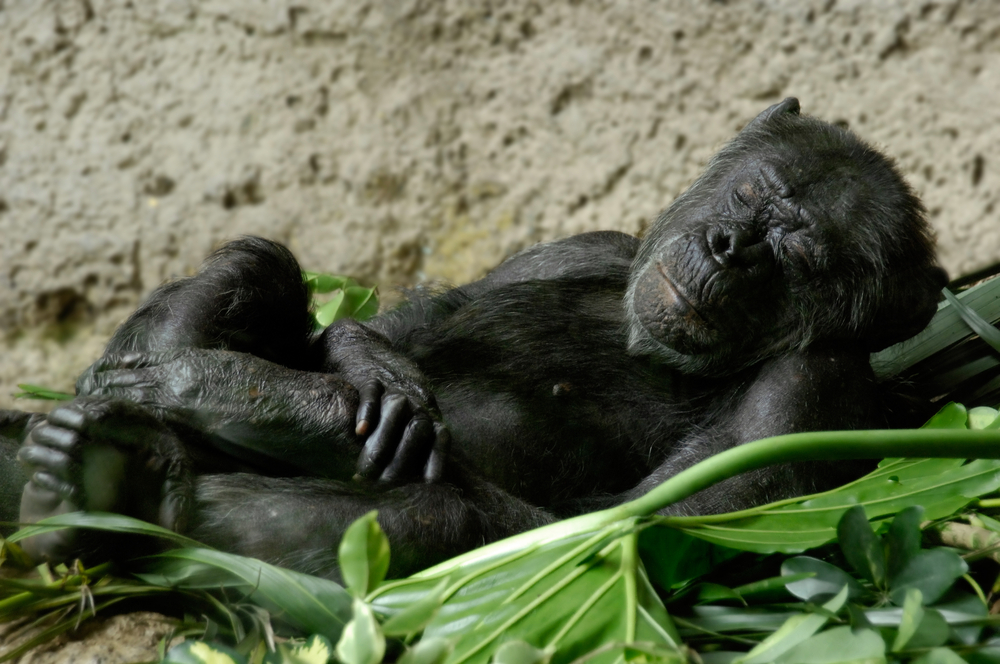Chimpanzees and their common ancestors have been sleeping without pillows for millions of years. Most people nowadays do use pillows.
Are pillows necessary?
Free Posture Crash Course!
Discover the crazy, simple 3-step formula that will teach you how to improve your posture and flexibility like a pro. You will learn how to hardwire the habit of good posture, reduce forward head and the secret way to stop slouching. It's 100% free!
Instinctive Sleeping
Humans are one of many species of primates – ancestors that lived in the trees of tropical forests. With the exception of humans, most primates live in tropical regions of Africa, Asia, and the Americas.
The earliest primates go back nearly 60 million years, and primates have been sleeping without pillows for a long time!

Great apes (that’s us) are unique in that they build sleeping nests or beds. Other primates, like Chimpanzees, sleep on branches. Chimpanzees build their nests from a sturdy tree called Ugandan ironwood. This may suggest that firm is best when it comes to sleeping. Or, more likely, firm branches prevent a weak branch from breaking and leaving the chimp vulnerable to predators.
How did humans sleep without pillows?
The question, if you think about it is a bit strange. If we think about sleeping in general, it is the ultimate relaxation. Unless you are extremely tired, you can actually sleep in almost any environment.
Have you ever fallen asleep when there is loud music on?
Have you slept in a tent?
There is no doubt that modern pillows do make us feel more relaxed, as do mattresses. However, there is no real physiological reason why we must have a pillow or a mattress.
We can fall to sleep quite easily without a pillow using a few basic tips:
- As much as possible, try to ensure you are in a quiet and dark place without too many distractions.
- Lie on your back and shut your eyes. Now you are at one with the ground, really try and feel it mold with your body.
- If this doesn’t work, then move over to your side and you can use an arm like your pillow.
This is pretty much how our ancestors and even cavemen slept comfortably without pillows.
It is believed that humans have been using some form of pillow for thousands of years, but the earliest pillows were very different from what we use today. The earliest pillows were made of stone, wood, or other hard materials, and were used to prevent insects and other small animals from crawling into a person’s mouth, nose, or ears while they slept.
As for how humans slept without soft pillows, they likely slept in a more upright or reclined position rather than lying flat on their backs, as is common today. They may have also used blankets or other soft materials to cushion their heads and support their necks while they slept.
Over time, pillows evolved and became softer and more comfortable, and they are now an essential part of many people’s sleep experiences. However, it is worth noting that pillows are not strictly necessary for a good night’s sleep, and some people find that they sleep better without one. The optimal sleeping position and pillow preference can vary from person to person, and it’s important to find what works best for you.
Michael Tetley Sleeping Positions
Michael Tetley is a physical therapist who wrote a book titled “Instinctive sleeping and resting postures: an anthropological and zoological approach to the treatment of low back and joint pain.” In this book, Tetley proposes that many modern-day health problems, including low back and joint pain, are caused by unnatural sleeping and resting postures.
The article suggests that we are too far removed from our primate origin. I remember my youth spent sleeping under the stars in nothing but a sleeping bag. Now, in my forties, I’d find it hard to relax and sleep on a hard floor, let alone a forest floor or tree branch!
According to Tetley, humans have lost touch with their instinctual sleeping and resting postures due to modern lifestyles, and this has led to chronic pain and discomfort. He argues that by adopting more natural postures during sleep and rest, individuals can alleviate these issues and improve their overall health.
Ideal Sleeping Positions According to Tetley
Tetley recommends sleeping on one’s side with a pillow between the knees, as this can help to align the spine and reduce pressure on the lower back. He also suggests resting on the floor or on a firm surface rather than on a soft mattress, as this can help to support the body’s natural curves and promote good posture.
Overall, Tetley’s approach emphasizes the importance of adopting more natural sleeping and resting postures in order to prevent and treat common musculoskeletal problems.
What Type Of Mattress is Best for Sleeping?
When you lie down on a hard, flat floor, you will immediately feel the tension in your body(try it). Once you sense your tightness, you can do something about it and let go of the areas that are holding stress and rigidity and release the stiffness.
When you get down on the floor, something has to give, and it’s not going to be the floor. That’s for sure! Think of the floor as your personal biofeedback device. Use your breathing to release tension and encourage relaxation.
So what type of mattress is best?
Choose whatever gets you a good night’s sleep, but I’m in love with my Sleepovation!
What is the Best Sleeping Position?
It is clear that sedentary ‘civilized’ people likely have a much higher incidence of musculoskeletal lesions (especially low back pain) compared with native peoples, nomads, and forest dwellers.
Anecdotal evidence suggests that low back pain and joint stiffness are markedly reduced by adopting natural sleeping postures.
The following table compares different human sleeping positions along with their pros and cons:
| Sleeping Position | Pros | Cons |
|---|---|---|
| Back (Supine) | – Aligns spine and neck, reducing the risk of pain | – May exacerbate snoring and sleep apnea |
| – Reduces the risk of developing wrinkles and pressure sores | – May not be suitable for pregnant women | |
| – Can help prevent acid reflux (when head is elevated) | ||
| Side (Lateral) | – Reduces the risk of snoring and sleep apnea | – Can cause shoulder and arm numbness |
| – Can help alleviate acid reflux | – May cause wrinkles and pressure sores | |
| – Recommended for pregnant women (especially sleeping on the left side) | – May lead to hip and shoulder pain if not properly supported | |
| Fetal | – Can help reduce snoring | – May cause strain on the neck and back if the spine is not properly aligned |
| – Comforting and secure feeling | – Can restrict deep breathing | |
| – Recommended for pregnant women | – May lead to wrinkles and pressure sores | |
| Stomach (Prone) | – May reduce snoring in some cases | – Puts strain on the neck and spine, increasing the risk of pain |
| – Can cause numbness and tingling in the arms and legs due to nerve compression | ||
| – May cause wrinkles and pressure sores |
Keep in mind that individual preferences and comfort levels play a significant role in choosing the most suitable sleeping position. If you’re experiencing sleep-related issues, it’s essential to consult a healthcare professional for personalized advice.
Natural Sleeping Positions
One such position uses a rotated arm as a pillow when side-lying. This allows you to listen out for danger with both ears. Note, that even the Chimpanzee sleeping position is remarkably similar to this ‘best’ sleeping position.
When lying on one side you do not even need to use your arm as a pillow. When your lower shoulder is fully hunched, the neck is supported. The neck then gently deviates towards the ground and gravity shuts the mouth (preventing insects from crawling in), and slight traction and elongation are applied to the cervical spine.
Do you still want to use a pillow?
Don’t worry. I haven’t gotten rid of mine. However, I am seriously testing out instinctive sleeping and trying out no pillow – I’ll let you know how I get on.
Tips for Different Sleepers:
1. Back Sleepers – try memory foam to mold to the curve of your neck
2. Side Sleepers – try a pillow between the knees and one for the neck to keep your spine aligned and neutral
3. Stomach Sleepers – avoid – stomach sleeping twists your neck and spinal cord 90 degrees!





One thought on “Are Pillows Really Necessary?”